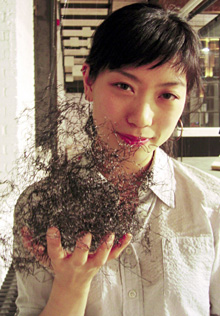Students' art reflects Concordia's physical transformation

Sun-Hye Hwang, a second-year MFA student from South Korea who is studying sculpture, said her wire installation is an exploration of how our memories of places provide a fixed reference point although the actual places are in a constant state of change.
What we remember about a place is often different from what the place actually looks like if we return and examine the location. Physical changes to buildings and landscape mean there is a dislocation between our remembered images of what places are like and what their actual appearance is, she said.
Photo by Robert Winters
There was a major buzz in the air at the vernissage, and it wasn’t from the DJ’s sound system.
Décalage, the recent show that featured 31 visual artists from the Master’s of Fine Arts program, took place in a masterfully renovated former laundry in St. Henri.
The reinvention of the Parisian Laundry building as an art space helped frame the theme of the show: the shift taking place at the university as it reinvents itself within the new architecture of Montreal’s downtown core.
That shift includes the “soft” opening on June 3 of the mammoth Engineering, Computer Science and Visual Arts complex, and the prospect of a gradual move over the years 2007 to 2022 into the Grey Nuns mother house.
The theme of change for the university within the city’s fabric was reflected in Superstructure, a piece by Laura St. Pierre, a second-year MFA student, who created an urban landscape on the floor of the gallery.
St. Pierre made the “buildings” by pouring plaster into styrofoam packaging materials from electronics devices, raising questions about the role of technology “in the narrative that the university constructs for itself as a cutting-edge institution.”
The plaster pieces are painted in seductive colours, St. Pierre said, because “the project of expansion is equally seductive.” But St. Pierre, who did a BFA at the University of Alberta, said her piece is not aimed at saying the university should not expand; rather, it is to raise awareness of the implications of expansion.
Geneviève Chevalier, a third-year MFA student in sculpture, presented an architecture-influenced installation made of boxes.
Her piece, which questions the large influence of the international style in urban architecture, is aimed at making viewers more aware of the city around them. Rather than destroying older buildings, steps like Concordia’s $16-million purchase of the Grey Nuns property “will help make students more aware of the history of Montreal.”
Youthful optimism
François Morelli, a Studio Arts associate professor, said work at the show “seems to have shed the prevalent irony of the last two decades, and engaged with the potential exuberance and innovation of renewal and youthful optimism.”
Thirty years after he studied here, he added, “It’s not the same place at all. What we’re going through now will deeply mark the next 30 years.”
Another MFA student-artist in the show, Mélanie Rocan, presented several miniature paintings that reflect the contrasts between life in the city and in a small town. In a big city, “you always have people bursting your bubble.” Rocan is a member of Winnipeg’s Two-Six artists’ collective, which posts work in Winnipeg’s public spaces as well as showing at more traditional galleries.
Bedroom installation
Shaunna Dunn also explored what lies between the private world and the big city. She created a bedroom installation, complete with a bed, from objects she collected.
She included an audio track with the sound of distant construction, perhaps a memory — or is this the sound backdrop from the university’s building projects?
In the large basement space of the gallery, an unusual three-screen video was presented by the Triptych, a three-member filmmaking group whose piece included three very distinct films, each made by one of the three student filmmakers.
The films included a variety of images, including a sequence with an actress crying and then taking off her wig while surrounded by film equipment, reminding the viewers of the cinematic illusion.
The wide-ranging show, organized by MFA student Jeanie Riddle, through a Carolyn and Richard Renaud graduate award, also included six MFA artists presenting their thesis shows.
One of these, Teresa Sapergia, said her work challenges art history traditions as it tries to find its own place in the art world.
“It’s the same with Concordia,” she said. “It’s been in flux so long, using these transient buildings; now, with the new facilities, it will be putting down roots of its own.”